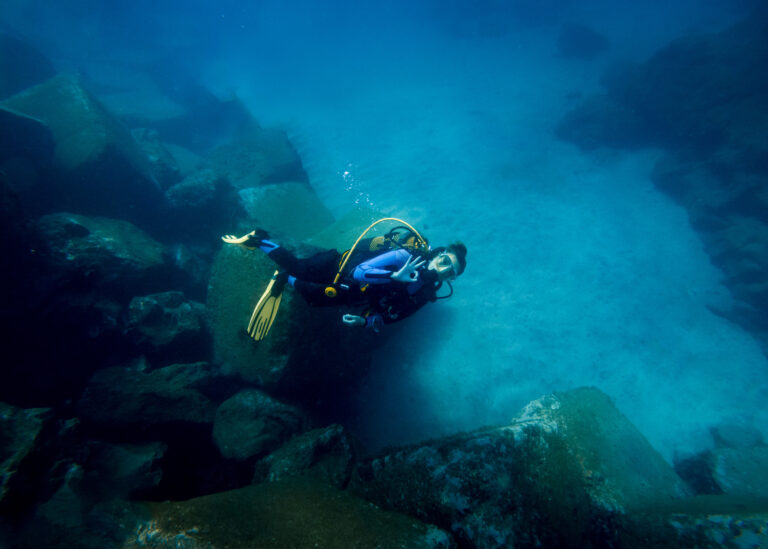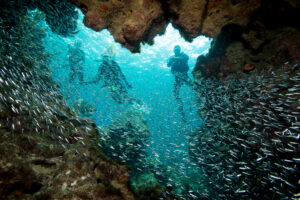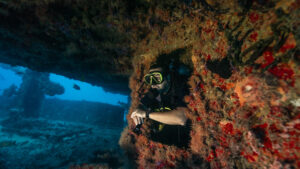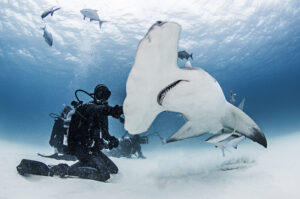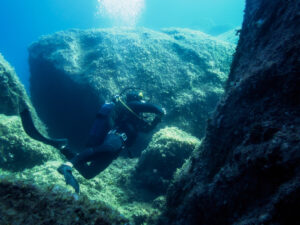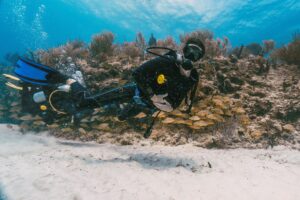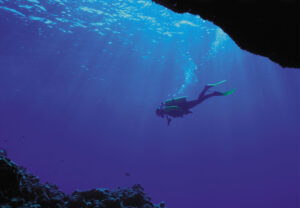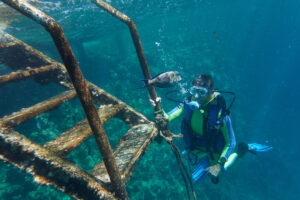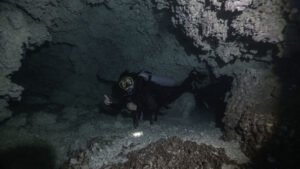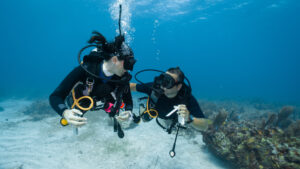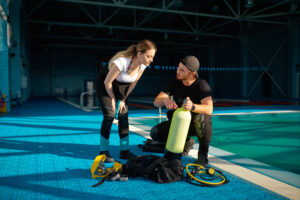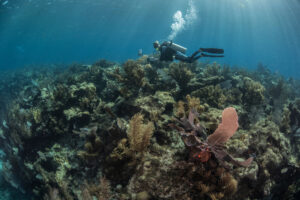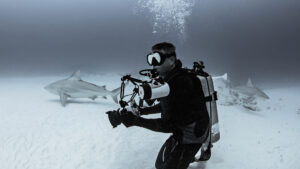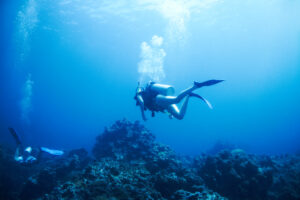What is a A-Frame?
An A-Frame is a ubiquitous fixture in the scuba diving world, as essential to many diving operations as the equipment divers wear themselves. This structural device plays a crucial role in the launch and recovery processes of various underwater apparatus. These systems include diving bells, stages, anchors, or remotely operated vehicles (ROVs)—all equipment frequently used in diving operations.
The A-Frame, named for its characteristic shape, is a type of gantry or davit. Gantry and davit are terms used to describe cranes that lift and move heavy objects, but each has its specific use cases. A gantry is typically a structure on wheels, designed to move along a track or on a set route. Davits, on the other hand, are more commonly fixed installations, used for lifting and lowering objects on ships. An A-Frame shares qualities with both of these, allowing for the versatile handling of heavy-duty submersible equipment in various contexts.
Construction and Design of A-Frames
A-Frame’s construction primarily focuses on maximizing strength and durability. They are typically composed of steel, allowing them to withstand the high forces exerted during the lifting and lowering of heavy equipment. The basic structure forms an ‘A’ shape, providing stability and balance when handling substantial weights.
The load of the equipment being launched or recovered is hoisted and lowered by cables attached to the apex of the A-Frame. The use of cables enables precise control of the load, ensuring safe and efficient operations.
Hydraulic rams are integral components in the operation of A-Frames. They are mechanical devices designed to exert a force in a straight line, generated from pressurized hydraulic fluid. When A-Frames are deployed, these hydraulic rams swing the frame either over the deck or overboard, as needed.
Operational Use of A-Frames in Scuba Diving
Deployment of Diving Bells
A-frames facilitate the deployment and recovery of diving bells, which are chambers used to transport divers to and from depth. The bell is suspended from the A-frame and lowered into the water, carrying the divers inside. Once the diving mission is completed, the A-frame hoists the bell back to the surface.
This operation requires the utmost precision and safety measures. The A-frame, with its strong structure and hydraulic capabilities, ensures the bell is accurately and securely placed into the water and subsequently retrieved.
Deployment of Stages and Anchors
Stages, also known as diving stages or wet bells, are open platforms used to lower divers into the water and bring them back to the surface. Anchors, on the other hand, are hefty devices used to hold a boat in place over the diving site.
The A-frame also plays a significant role in handling these pieces of equipment. With its robust design, it can comfortably manage the weight of these heavy objects, while the hydraulic rams provide the necessary movement to guide the stages and anchors overboard or back onto the deck.
Deployment of Remotely Operated Vehicles (ROVs)
Large ROVs are sophisticated pieces of equipment used for various underwater activities, such as exploration, data collection, and maintenance tasks. These machines can weigh several tons and require a robust system to manage their launch and recovery.
The A-frame, with its superior strength and control, is often the equipment of choice for this purpose. The frame can swing the ROV overboard, lower it to the desired depth, and then recover it once the operation is complete.
Safety Considerations with A-Frames
Given the A-frame’s critical role and the potential for catastrophic failure should it malfunction, rigorous safety measures are essential when operating these devices.
Regular Maintenance
Regular inspections and maintenance of the A-frame are non-negotiable. These procedures are essential to detect any signs of structural weakness or mechanical faults, ensuring the continued safe operation of the equipment. This is particularly important for A-frames used in marine environments, where corrosion from saltwater can quickly degrade metal structures.
Maintenance should include inspecting the frame for any visible damage, such as cracks or distortions, and checking the hydraulic rams and hoisting cables for signs of wear. Any parts showing signs of damage should be replaced promptly to prevent failure during operations.
Operational Procedures
A key aspect of safety when working with A-frames is adhering to standard operating procedures (SOPs). These guidelines set out the correct and safe way to use the A-frame for launching and recovering equipment.
For example, operators must ensure the load is correctly attached to the A-frame before attempting to lift it. Additionally, all people on deck should be clear of the A-frame and its load during operations to avoid injury should a malfunction occur.
Advancements and Innovations in A-Frame Design
Despite its fundamental design remaining relatively consistent, there have been noteworthy advancements in the technology and features of A-frames.
Improvements in Materials
The use of materials with enhanced properties, such as higher strength or better corrosion resistance, has improved the durability and performance of A-frames. Stainless steel and other alloys resistant to corrosion are increasingly being used, particularly for A-frames exposed to harsh marine environments.
Further, coatings and treatments can be applied to the A-frame’s metal surfaces to provide additional protection against environmental factors like saltwater and UV radiation.
Technological Advancements
As technology progresses, so does the sophistication of A-frames. Modern A-frames often include features such as automated control systems, providing more accurate and efficient operation. These systems can precisely manage the movement and speed of the A-frame, reducing the risk of human error during operations.
Additionally, load sensing technologies can monitor the weight of the load being lifted, providing real-time feedback to the operator and ensuring the A-frame is not overloaded.
Despite being a relatively simple piece of equipment, the A-frame’s role in scuba diving operations is irreplaceable. Its strength, versatility, and operational capability make it an essential tool for safely launching and recovering heavy underwater equipment. With ongoing advancements in materials and technology, the future of A-frames in scuba diving operations looks set to become even more efficient and reliable.
Role of A-Frames in Underwater Archaeology and Exploration
A-frames play a particularly important role in underwater archaeology and exploration. These operations often involve the deployment and recovery of substantial, delicate equipment, and sometimes, recovered artifacts.
Underwater Archaeology
Archaeologists often use large remotely operated vehicles (ROVs) to explore underwater sites, map terrain, and recover artifacts. In these sensitive operations, A-frames are used for their precision and control. They allow for the careful handling of equipment and artifacts, preventing damage to potentially priceless objects.
Moreover, the recovery of large items, such as cannons from shipwrecks or sizeable structural pieces of ancient submerged cities, often depends on the strength and stability of A-frames. These frames play a key role in the archaeological process, facilitating the recovery of objects that tell stories from our past.
Underwater Exploration
Deep-sea exploration ventures to extreme depths and often encounters harsh conditions. The use of ROVs is essential to these operations due to the challenging environments that are unsuitable for human divers. These ROVs are typically of substantial size, housing advanced technology such as deep-sea cameras, sonar mapping systems, and robotic arms.
A-frames contribute significantly to these operations, handling the ROVs’ deployment and recovery. The stability, strength, and precision of the A-frame are paramount in ensuring the ROV can perform its exploration tasks efficiently and safely.
A-Frames in Commercial and Industrial Diving Operations
Commercial and industrial diving often involves work on underwater structures such as oil rigs, pipelines, and ship hulls. This type of diving requires the deployment of divers and various pieces of heavy equipment to significant depths.
Deployment of Divers and Equipment
In commercial and industrial diving operations, A-frames are frequently used to lower diving stages—platforms that carry divers into the water—and to transport heavy equipment to and from the work site. The ability to handle such weights safely and efficiently is vital to the operation’s success, making the A-frame an essential piece of equipment.
Recovery and Safety
Following underwater work, the A-frame’s role shifts to recovery. It hoists divers and equipment from the water, a task that can become especially critical if a diver is in distress or if swift retrieval of equipment is necessary. In such cases, the A-frame’s reliable performance can mean the difference between a successful operation and a potentially disastrous situation.
Through the continued evolution of A-frame technology and design, this integral piece of equipment continues to shape the future of underwater operations. Its strength, precision, and versatility make it indispensable across various fields, from recreational scuba diving to complex industrial operations and archaeological exploration. Its presence will undoubtedly remain a constant as we continue to explore the depths of our world’s waters.
Training and Certification for A-Frame Operations
Given the pivotal role that A-frames play in various diving operations, specific training and certification are crucial for those tasked with operating these devices.
Operator Training
Training for A-frame operators typically covers several essential topics. These include understanding the principles of operation, learning how to conduct regular maintenance checks, and practicing the safe operation of the equipment. Trainees also learn how to identify potential issues that could lead to equipment failure, and the steps to take if such problems arise.
In many cases, this training involves a combination of classroom instruction and hands-on practice. The latter provides operators with invaluable experience in using A-frames, under the watchful eye of experienced trainers.
Certification Programs
Certification programs add another layer of assurance that A-frame operators have the skills and knowledge necessary to carry out their tasks safely and efficiently. These programs often involve a rigorous assessment process, including both written and practical exams.
Upon successful completion of a certification program, operators are granted a certificate or license. This accreditation serves as proof of their competence in operating A-frames, making them valuable assets in diving operations that require the use of this equipment.
Environmental Impact and Sustainability Considerations
As with any mechanical device used in the marine environment, A-frames must be used and maintained responsibly to minimize their environmental impact.
Material Selection and Disposal
Choosing materials that resist corrosion is not only beneficial for the A-frame’s longevity but also reduces the potential for harmful substances to leach into the marine environment. Similarly, when A-frames reach the end of their useful life, they must be disposed of responsibly to prevent harmful materials from entering the environment.
Minimizing Disturbance
While A-frames play an essential role in diving operations, it’s crucial to ensure they are used in a way that minimizes disturbance to marine life. This includes careful planning of diving operations to avoid sensitive areas, and ensuring the A-frame and associated equipment are operated in a manner that reduces noise and vibration.
Through conscious practices and a commitment to sustainable operations, the scuba diving industry can continue to rely on A-frames as invaluable tools while preserving the health and beauty of our marine environments.
A-Frame: The Past, Present, and Future
While the A-Frame has a long history, its essential role has remained consistent, and advancements continue to propel this critical device into the future of diving operations.
Historical Background
The A-frame’s roots can be traced back to ancient lifting devices used in construction and shipbuilding. Over centuries, this technology evolved into the modern A-frame we use today. Despite changes in materials, size, and technology, the primary function of lifting and lowering heavy objects has remained the same.
In the context of scuba diving, the A-frame became a staple as diving operations expanded and more sophisticated equipment was developed. It made it possible to transport divers and complex, heavy equipment to and from the depths, making underwater exploration, construction, and recovery feasible on a scale never before possible.
Present Applications and Advancements
Today, A-frames continue to be used extensively in various diving operations. Advancements in technology have led to improvements in the design and functionality of A-frames, making them safer and more efficient. Automation, real-time load sensing, and enhanced materials have all contributed to the increased performance and versatility of these devices.
Furthermore, specific training and certification programs have evolved to ensure the safe and effective operation of A-frames. This focus on education underscores the importance of this device in the diving industry.
Future Prospects
Looking forward, it’s clear that the A-frame will continue to play a crucial role in diving operations. Technological advancements will further increase the A-frame’s efficiency and versatility, and potentially open up new applications for this device.
For instance, the rise of autonomous underwater vehicles (AUVs) could lead to the development of automated A-frames capable of deploying and recovering these devices without human intervention. In deep-sea exploration and underwater archaeology, advancements in A-frame technology could enable the retrieval of heavier objects from greater depths.
Indeed, as long as there is a need to explore, work, and recover objects from our world’s waters, the A-frame will continue to be an indispensable tool. Its enduring relevance testifies to the genius of its simple, yet effective design. As we continue to innovate and adapt, the A-frame will undoubtedly evolve alongside us, ready to meet the challenges of the underwater world.

